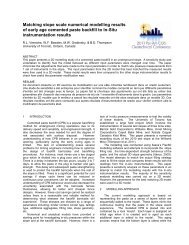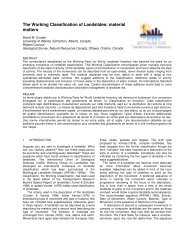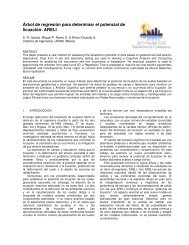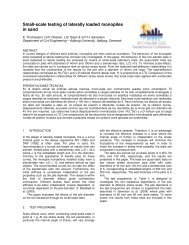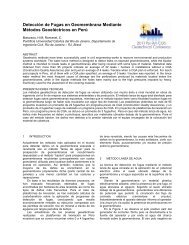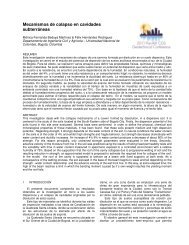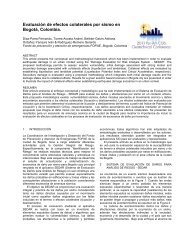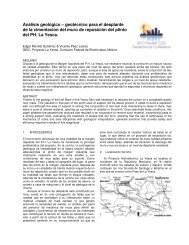MS Word Technical Paper Template
MS Word Technical Paper Template
MS Word Technical Paper Template
Create successful ePaper yourself
Turn your PDF publications into a flip-book with our unique Google optimized e-Paper software.
ACKNOWLEDGEMENTS<br />
The writers would like to acknowledge the financial<br />
support provided through the Discovery Grants program<br />
of the Natural Sciences and Engineering Research<br />
Council. The equipment grants awarded by the Canada<br />
Foundation for Innovation and Ontario Innovation Trust<br />
were instrumental in establishing the experimental<br />
infrastructure used for this research. Authors very much<br />
appreciate, and acknowledge the help of Prof. Juan<br />
Salinas in translating the abstract.<br />
REFERENCES<br />
Figure 9: Variation of Kα correction factor<br />
5 SUMMARY & CONCLUSIONS<br />
An experimental research program intended to<br />
systematically delineate the effects of overconsolidation<br />
on currently used seismic resistance factors was<br />
undertaken. All test were performed using the cyclic<br />
simple shear device to simulate the loading conditions insitu<br />
during earthquakes.<br />
The number of cycles to induce liquefaction increases<br />
exponentially with OCR. The increase in the cyclic<br />
resistance ratio, CRR is quite significant, but not at a<br />
comparable rate at which the number of cycles increase.<br />
The ratio of the CRR of the overconsolidated sand to that<br />
of normally consolidated appears to vary essentially<br />
linearly with OCR, and is independent of the effective<br />
confining stress level. Overconsolidation reduces both the<br />
K σ and K α factors. The reduction in K α factors is rather<br />
significant. Use of K α factors determined from NC sands<br />
could lead to unsafe designs in overconsolidated sands.<br />
However, the reduction on K σ factor is negligible for<br />
practical purposes.<br />
The findings reported herein were based on<br />
experimental studies on one fluvial sand, and cannot be<br />
readily extended to other sands, or even to the same sand<br />
without appropriate consideration of the effects of soil<br />
fabric. However, it provides a framework that permits<br />
appropriate site characterization from reference cyclic<br />
resistance values. The differences between K OCN and<br />
K OCR values suggest that ground improvement using<br />
overconsolidation can be a very effective strategy to<br />
safeguard against liquefaction failures in the event of<br />
distant earthquakes with large magnitudes, as opposed to<br />
the case of smaller earthquakes that occur relatively<br />
closer to the site. Given the strength gains noted in the<br />
study, it is clear that appropriate consideration of the<br />
strength gains due to overconsolidation would lead to<br />
significant cost-savings in seismic design.<br />
Adalier, K. & Elgamal, A., 2005, Liquefaction of overconsolidated<br />
sand: a centrifuge investigation, Journal<br />
of Earthquake Engineering, Vol. 9, Special Issue 1,<br />
127-150, Imperial College Press, 2005.<br />
Bjerrum, L. and Landva, A., 1966, Direct simple-shear<br />
tests on a Norwegian quick clay, Geotechnique, 16(1):<br />
1-20.<br />
Boulanger, R.W. & Idriss, I.M., 2004, State normalization<br />
of penetration resistances and the effect of<br />
overburden stress on liquefaction resistance, In Proc.<br />
of the 11th International Conference on Soil Dynamics<br />
and Earthquake Engineering, and 3rd International<br />
Conference on Earthquake Geotechnical Engineering,<br />
Stallion Press, 2: 484-491.<br />
Dyvik, R., Berre, T., Lacasse, S., and Raadim, B., 1987,<br />
Comparison of truly undrained and constant volume<br />
direct simple shear tests, Geotechnique, 37(1): 3-10.<br />
Harder, LF & Boulanger, RW, 1997, Application of K σ and<br />
K α correction factors, In Proc. of the NCEER<br />
Workshop on Evaluation of Liquefaction Resistance of<br />
Soils, National Center for Earthquake Engineering<br />
Research, SUNY at Buffalo, pp. 167–190.<br />
Haynes, ME & Olsen, RS, 1998, Influence of confining<br />
stress on liquefaction resistance, In Proc. of the<br />
International Workshop on the Physics and Mechanics<br />
of Liquefaction, Eds. Lade, PV, and Yamamuro, JA,<br />
Baltimore, Maryland, USA. Sept 10-11, 1998.<br />
Idriss, I. M. & Boulanger, R.W., 2003. Estimating K α for<br />
use in evaluating cyclic resistance of sloping ground,<br />
8th U.S. - Japan workshop on earthquake resistant<br />
design of lifeline facilities, and counter measures<br />
against liquefaction, Eds. Hamada, M, Bardet, J and<br />
O’Rourke, TD, Tokyo, Japan. Dec 16-18, 2002, 21p.<br />
Ishihara, K., Sodekawa, M., and Tanaka, Y., 1978, Effects<br />
of overconsolidation on liquefaction characteristics of<br />
sands containing fines, Dynamic Geotechnical<br />
Testing, ASTM Special <strong>Technical</strong> Publication 654,<br />
ASTM, Philadelphia, pp. 246–264.<br />
Ishihara, K. & Takatsu, H., 1979, Effects of overconsolidation<br />
and K0 conditions on the liquefaction<br />
characteristics of sands, Soils and Foundations,<br />
19(4):59-68.




